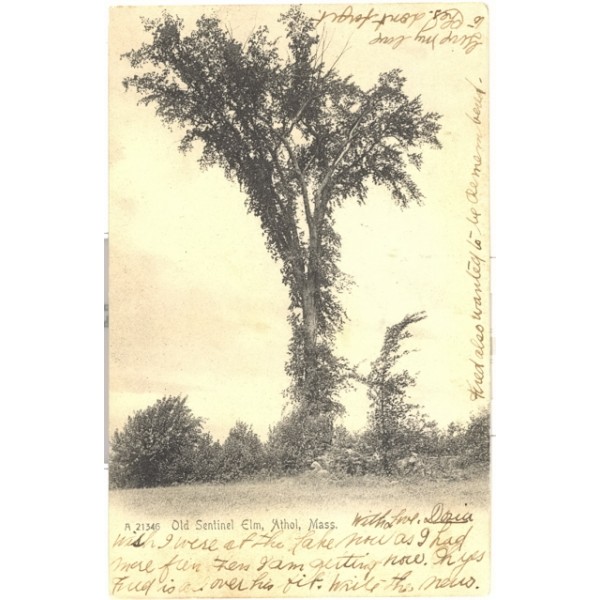There has been much debate about the inspiration for the name of “Sentinel Hill” in Lovecraft’s “The Dunwich Horror”. W. Paul Cook declared (Joshi, Annotated Lovecraft, p.114) that the name was the only topographical inspiration Lovecraft took away with him from his Summer 1928 visit to Cook at Athol…
“During most of the years of my acquaintance with Lovecraft I was living in a north central Massachusetts town [Athol] which was the most absolutely devoid of historical, architectural, scenic, archeological [or other inspirations… except the Sentinel]”
I found this mention in the the book Athol, Massachusetts, past and present (1899), which explains Cook’s reference…
“To the west, across the intervening valley, is “West Hill,” one of the locations of the early settlers, with its “Sentinel Elm,” a landmark seen from every direction.”
I also found a postcard photograph of the same Sentinel Elm at Athol. It looks distinctly weather-beaten and not that ancient judging by the size of the trunk. It had presumably vanished by the time of the earliest Lovecraftian geographers, who could only find a nearby Sentinel Elm Farm. The card is currently for auction…
The Elm presumably gave its name to Athol’s first newspaper, Freedom’s Sentinel.
Here it is in colour…
And here in a Lovecraftian sunset…
The same page of the book Athol, Massachusetts, past and present that talks of the “Sentinel Elm” has a small and rather nice ink sketch of “Round Top Mt” — there is a “Round Mountain” that provides local colour at the start of “The Dunwich Horror”…
Although the Wilbraham Mountains are also rounded, which was where Lovecraft went directly he left the uninspiring topography of Athol in Summer 1928, to go to nearby East Wilbraham to stay with Mrs Miniter and Miss Beebe.






Beautiful photograph of Wilbraham mountains taken from Glendale Cemetery. I believe Evanore Olds Beebe (1858-1935) is buried in Glendale Cemetery. Edith (Dowe) Miniter (1867-1934) is buried in the Tupper lot at Woodland Dell Cemetery in Wilbraham but has no marker. Her mother Jennie (Tupper) Dowe (1840-1919) was cremated; her ashes were scattered in Wilbraham by HPL and Edward Cole in 1935.
Pingback: Dunwich: Sources and Ideas for Writers | Sentinel Hill Press